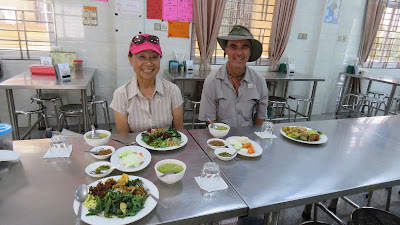Fresh mangos!
Lychee nuts.
A marble craftsman carving a buddha.
A buddha marble shop.
The Buddha.
The Pagoda.
and pounding it for 30 minutes at a time.
Now I'm worth something.
Young and I having lunch in a small local restaurant.
Some of the selections from the buffet.
The Golden Palace Monastery.
One of the over 700 engraved tablets of Buddhas teachings.
That are housed in these individual buildings.
For young monks before chanting.
Friday, May 25th.
Actually, it wasn’t the road to Mandalay, but rather a
flight. We were up early and Win Han drove us to the airport. We caught a
ninety-minute flight to Mandalay. As soon as we left the airport and got on the
road to Mandalay Pu Pu had the driver stop at two fruit stands. We all bought
fresh mangos at the first one and lychee (because I had mentioned I liked them
better than rambutan) at the second.
When we got to Mandalay we visited two shops to see
local craftsmen at work. The first was a marble carving shop. There were about
a dozen of them on the same stretch of town, and they were all carving mostly
Buddha statues from marble. The fine white dust was everywhere. The men doing
the carving were using electric tools and no masks and were covered with it. I
cannot imagine their lungs.
Next, we visited the 100-year-old legendary Arakan
Buddha, which stands at 3.5m (11.5 ft) tall. Made of bronze and covered in gold
leaf, this gorgeous Buddha is a major pilgrimage site. The buddha is housed in
a chapel at the end of a long corridor. Male devotees buy small sheets of gold
leaf and climb to the platform where they rub the leaf onto the crossed legs or
knees of the bronze cast statue. Apparently, over the last hundred years, the
buddha has thickened on the legs by six inches. The local people believe it is
alive as it seems to grow in proportion all over to match the legs. The women
can sit and pray just outside the chapel and watch the men on a close circuit
TV.
The second shop was a gold leaf making shop. The
process of turning 24 carat gold into gold leaf takes time, traditional methods
and a lot of back breaking effort. The gold has to be pounded manually by men
with five kilo hammers three separate times, twice for thirty minutes and once
for three hours. There is a way to do this by machine, but apparently the
devotees prefer the traditionally, manually pounded leaf. This is another job I
would never want to have.
Then we visited the Kuthodaw Pagoda which is a Buddhist
stupa that claims the honour of housing the world’s largest book. Actually, the
Tripitaka, the teachings of Buddha were carved in their entirety onto stone
tablets at the foot of Mandalay Hill.
It has 730 tablets, front and back for 1460 pages; each page is 107 centimetres
(3.51 ft) wide 153 centimetres (5.02 ft) tall and 13 centimetres
(5.1 in) thick. Each individual tablet is housed in its own separate white
building and they are arranged around a central golden pagoda. Thus, they call
this the world’s largest book, not to mention heaviest! The place really
reminded me of the Recoleta cemetery in Buenos Aires, where Eva Peron is
buried, where the family crypts are above ground.
We had lunch at a small restaurant famous with the
locals for its buffet. We tried a variety of local meat and vegetable dishes
along with soups and a drink.
After lunch we visited Shwenandaw Kyaung, otherwise
known as the "Golden Monastery," that was originally part of the
royal palace at Amarapura. It is the only building that remains from the
original palace. The palace was built in a 2km x 2km walled complex with over a
hundred buildings and surrounded by a wide moat. The wall and the moat still
exist, but the palace was bombed and burnt down by the Allies in the Second World
War because the Japanese were using it for their headquarters and to house
their troops. This building had been removed earlier by the last Myanmar king
and donated to the monks as a monastery. It is a beautiful building made
entirely from teak wood. Its delicate wood carvings are of Buddhist myths. The
ceiling is gold leaf and the teak has aged to a dark colour.
Then we drove up Mandalay Hill. There was an option to
climb the 1800 steps and 240 vertical metres to Mahamuni Pagoda, but we decided
not to because of the heat, humidity and time, we still had another visit to
make. At the summit there was a plethora of pagodas and monasteries sitting
atop it and the views of Mandalay were very impressive.
Finally, we visited the Shwe Kyin Monastery which is
one of the oldest and most important monasteries in the country. Here many
young monks are trained in the ways of Buddhism. Every evening, visitors can
watch the novice monks as they line up and walk to the prayer hall in the monastery
in procession, chanting as they go. Once they get inside, they all sit in front
of the Buddha statue and spend the evening chanting.
After observing and listening for a bit, we left and
went back to the hotel. We decided to forego dinner and just eat our mangos and
lychee. After a long day in the 35+ degree heat, it was nice to relax for the
evening in my air-conditioned room. Early night.
















No comments:
Post a Comment